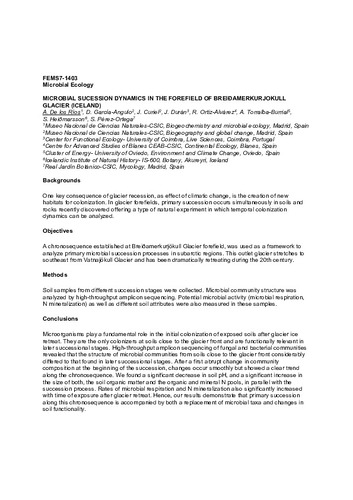Microbial sucession dynamics in the forefield of Breiðamerkurjokull Glacier (Iceland)
Palabra(s) clave:
Microbiology
Microbial ecology
Microbiología
Ecología microbiana
Sucesión
Comunidades
Succession
Glaciers
Microbial communities
Communities
Climate change
Iceland
Cambio climático
Islandia
Colonization
Fecha de publicación:
Editorial:
Federation of European Microbiological Societies (FEMS) : Spanish Society for Microbiology (SEM)
Descripción física:
Resumen:
Backgrounds One key consequence of glacier recession, as effect of climatic change, is the creation of new habitats for colonization. In glacier forefields, primary succession occurs simultaneously in soils and rocks recently discovered offering a type of natural experiment in which temporal colonization dynamics can be analyzed. Objectives A chronosequence established at Breiðamerkurjökull Glacier forefield, was used as a framework to analyze primary microbial succession processes in subarctic regions. This outlet glacier stretches to southeast from Vatnajökull Glacier and has been dramatically retreating during the 20th century. Methods Soil samples from different succession stages were collected. Microbial community structure was analyzed by high-throughput amplicon sequencing. Potential microbial activity (microbial respiration, N mineralization) as well as different soil attributes were also measured in these samples.
Backgrounds One key consequence of glacier recession, as effect of climatic change, is the creation of new habitats for colonization. In glacier forefields, primary succession occurs simultaneously in soils and rocks recently discovered offering a type of natural experiment in which temporal colonization dynamics can be analyzed. Objectives A chronosequence established at Breiðamerkurjökull Glacier forefield, was used as a framework to analyze primary microbial succession processes in subarctic regions. This outlet glacier stretches to southeast from Vatnajökull Glacier and has been dramatically retreating during the 20th century. Methods Soil samples from different succession stages were collected. Microbial community structure was analyzed by high-throughput amplicon sequencing. Potential microbial activity (microbial respiration, N mineralization) as well as different soil attributes were also measured in these samples.
Descripción:
FEMS 2017 (7th. 2017. Valencia)
Patrocinado por:
Ministerio de Economía y Competitividad, Plan Nacional de I+D+i proyecto referencia CTM2012-38222-C02-02
Colecciones
- Ciencias de la Educación [1072]
- Investigaciones y Documentos OpenAIRE [8420]
- Pósteres [94]
Ficheros en el ítem




